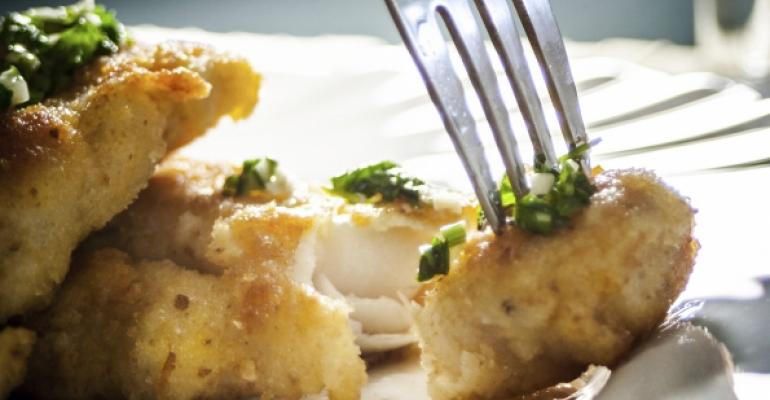When it comes to seafood, today's chefs, restaurant goers and suppliers often are looking for the same things — a high quality dining experience and a sustainable product. For premium tilapia and other first-rate fish, experts point out, the answer lies in aquaculture.
However, the challenge facing chefs and their suppliers is that consumers might harbor misconceptions about farm-raised fish, not realizing that aquaculture can provide all-natural seafood that tastes delicious and does no harm to the environment.
“There is good and bad farming in anything,” says Magdalena Wallhoff, whose family owns Regal Springs, a Miramar, Fla.-based supplier of premium tilapia. “You hope that the chicken the chef chooses is well farmed chicken. It’s the same with aquaculture. You can choose exceptionally well raised fish, and that’s what our tilapia is.”
Regal Springs offers 100 percent, all natural, lake-grown tilapia. The fish are grown in pristine, deep-water lakes in Mexico, Honduras and Indonesia. Because the tilapia are in large floating pens, they do not contain mercury or other contaminants that are found in some wild fish. The all natural fish also are raised without chemicals, growth hormones or antibiotics.
“The waters we farm are exceptionally clean, and we use less than 1 percent of any surface area,” Wallhoff says. “The misperception of aquaculture is of muddy ponds and stocking density through the roof. We have relatively low stocking density.”
In addition, the fish are fed a diet of high quality, U.S.-grown grains. That means Regal Springs is not taking smaller fishes from an ocean and feeding them to the tilapia, Wallhoff says. That’s important for premium seafood because it means the fish taste better. “There is no waste fed to the fish,” she says. “It’s all fresh cereals.”
Aquaculture is playing an important role in helping operators menu all natural fish from sustainable sources and meet ever increasing consumer demands for premium seafood.
“The future of increased seafood consumption is aquaculture,” says Gavin Gibbons, vice president of communications for the National Fisheries Institute in McLean, Va. People are eating more seafood than ever, and the oceans are fished to what the industry calls “maximum sustainable yield.”
“As long as there is responsible fisheries management in place the oceans will continue to provide the amount of seafood they provide now, but they will not provide more,” Gibbons says.
Seafood providers are innovating to keep pace with demand for sustainable seafood, Gibbons says, and fish farming, or aquaculture, ranks as one of the most innovative processes being used today. The challenge, he says, is that consumers believe ocean-caught fish is more appealing. “Consumers are conditioned to choose wild over farmed, and they don’t know why they do that,” he says. “They just say, ‘Is that wild? I’ll have it if it is.’”
In fact, aquaculture is not in competition with wild capture. “They actually work in concert,” Gibbons says. “Aquaculture is the release valve for the pressure on the oceans in terms of sourcing.”
Operators who are interested in maintaining a sustainable supply of seafood have a challenge in deciding which providers are supplying high quality seafood while remaining environmentally conscious.
“Chefs have a powerful role to play in the future of sustainable food systems by supporting the farmers that are doing the right thing,” says Sheila Bowman, manager of culinary and strategic initiatives for the Monterey Bay Aquarium Seafood Watch program. “Like other forms of farming, chefs want to be familiar with the people and operations raising their seafood.”
Operators do this because it is important for the industry to continue to have natural seafood, and also because consumers demand it. Michael Oshman, chief executive and founder of the Boston-based Green Restaurant Association, says the association includes sustainable cuisine among its certification standards. According to association statistics, 79 percent of consumers say they prefer to eat at Certified Green Restaurants, while 78 percent of employees say they would be more excited to work at Certified Green Restaurants.
Although consumers want to feel good about the foods they eat, they typically are not going to memorize dozens of different standards and then examine every restaurant website to determine if the menu matches each detail. Many would prefer to see a short cut such as an icon or logo that denotes sustainability. For example, diners might look for a logo from one of the certification bodies or find reassurance from a known brand, like Regal Springs, posted on the menu.
In fact, Wallhoff says, people have told her that they hesitated to order farm-raised seafood at restaurants until they saw the Regal Springs logo on the menu. “One caller told me, ‘I wanted to order the tilapia, but I had heard bad things about farm-raised seafood, and then I saw your logo. If they are bothering to put a logo there, then it must be good.’”




